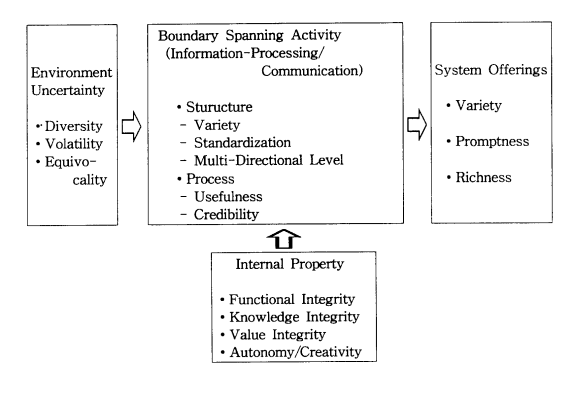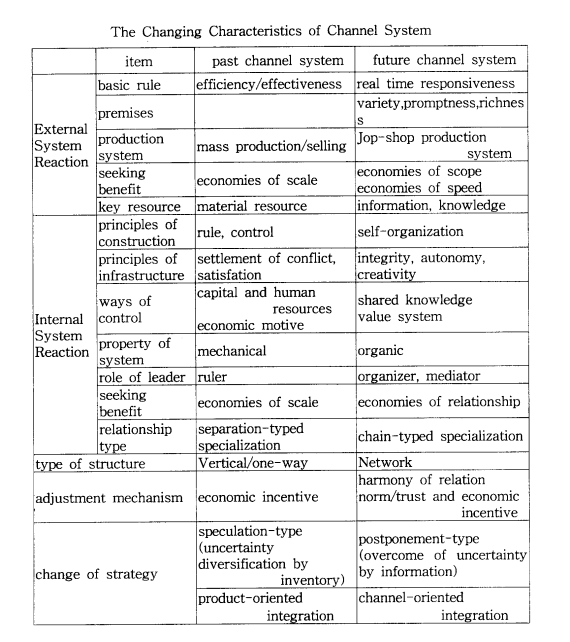
Abstract
A Study on the Development of the Criteria for Channel Design and Audit
Ⅰ. Introduction
With the acceleration of the change in consuming patterns and technical developments, which are the hard core in business environment, the composition, interation and specialization in (retail) business type has been continuing. Recently, the mutual cooperation and alliance between manufacturing companies and distribution companies, and more, the fusion of manufacturing and marketing is a frequent and striking phenomenon. The marketing channel system plays a pivotal role in business activities to provide customer satisfaction. Therefore, it is often represented as followings : customer value creation network, value added providing network, in-depth and speedy collecting channel of the demand trend and consumer response. The establishment of marketing channel system takes too much time and efforts. And the established marketing channel system can not be changed with ease. Marketing channel system should be controlled from the strategic point of view to maintain long-term competitive advantage. To do this, many steps should be taken as follows. (1) The introduction of integrative and cyclical viewpoint on the design/operation/audit of marketing channel system. (2) The extension of time span from a static short-term viewpoint to a dynamic long-term viewpoint. (3) The extension of spacial range from a dyadic relationship network to multi-relationship network.
In this research, marketing channel system in terms of information processing and communication, is defined as 'an open system linked with network, which processes information and creates knowledges through the communicative process beyond system or within system to respond to the uncertainties of external and internal environments.'
Under this viewpoint on the marketing channel system, the purpose of this dissertation is to develop the criteria for channel design-operation-audit and evaluate the effectiveness of the developed criteria. To put it concretely, those are as follows.
1) How we should make a conceptual framework to enlarge the concept of marketing channel system and design/operation/audit it from the integrative viewpoint, regarding marketing channel system as an open system linked with network, which processes information and creates knowledge through the communicative process beyond and within system ?
2) What are the basic principles in order to respond to external environment (such as the change of demand characteristics) of marketing channel system ?
3) What are in the basic principles of the intrasystem to work external principles of the marketing information system ?
4) How about the effectiveness and applicability of the developed conceptual framework and model ?
The purpose of this research is to answer to these questions.
Ⅱ. Theoretical Foundation Research
The results of the major previous researches on designing/operating/auditing marketing channel system have been reviewed systematically. As a result, it can be concluded that many criteria, which are mentioned in this paper, seems to be too macroscopic or narrow to adapt to rapidly changing environment.
So, based upon the general system theory, information-processing view in terms of contingency theory, the communication theory, boundary spanning unit in the inter-organization theory, the conceptual framework for recognizing marketing channel system is constucted.
Ⅲ. Conceptual Framework
Marketing channel system is the IO system that passes resources and information through boundary spanning unit linked with external environment. It is conceptualized to be multi-layers which have function/activity network, knowledge/information network, value network.
Under the above conceptual framework, the new principles applicable to marketing channel system are derived not only from the inner oriented viewpoint but also from the outer oriented viewpoint.

The identification, sufficiency and creation of demand is a key to successful marketing channel system, reacting to the diversity, equivocality and volatility of the external environment.
To do these the design and operation of the efficient system is needed on the basis of the variety, richness and promptness of the criteria. Information and knowledge do their part as core resources to make the best use of economies of scale and speed under the Job shop production and flexible system.
To put into action above-mentioned outer-oriented basic principles depends on the self-organization as an inner-oriented basic rules harmonized with integrity, autonomy and creativity. A channel leader is not considered as a ruler, but as an organizer or a coordinator. This is the system linked with chain-typed specialization based on economies of networking and systematic relationship.
Shared knowledge and value system becomes the important internal controller. The structural vertical typed channel system will change into network-typed system gradually. At the same time the adjustment mechanism will shift from to ecnomic incentive system to the relationship and trust system.
Also, the marketing channel system strategy will shift from speculation-typed uncertainty diversification strategy to postponement-typed uncertainty minimization strategy.
The marketing operations will be integrated by channels, not by products.
Ⅳ.Research Hypothesis
To evaluate the efficiency of conceptual framework and new principles, the following hypothesis are proposed.
1) Hypothesis regarding on the relationship between the uncertainties of demand and information processing property.
H 1-1: The higher the diversity level in external system environment (uncertainty of demand) is, the higher is the diversity level of information processing in boundary spanning unit.

H 1-2 : The higher the diversity level in external system environment (uncertainty of demand) is, the higher is the standardization level of the information processing in boundary spanning unit.
H 2 : The higher the volatility level in external system environment (uncertainty of demand) is, the higher is the standization level of the information processing in boundary spanning unit.
H 3-1 : The higher the equivocality level in external system environment (uncertainty of demand) is, the higher is the standardization level of the information processing in boundary spanning unit.
H 3-2 : The higher the equivocality level in the external system environment (uncertainty of demand) is, the higher is the multi-directional level of the information processing in boundary spanning unit.
2) Hypothesis regarding on the relationship between the internal property of channel system and the information processing property.
H 4 : The higher the knowledge integrity level of marketing channel system, the higher is the usefulness level of the information processing in boundary spanning unit.
H 5-1 : The higher the value integrity level of marketing channel system, the higher is the usefulness level of the information processing in boundary spanning unit.
H 5-2 : The higher the value integrity level of marketing channel system, the higher is the credibility level of the information processing in the boundary spanning unit.
H 6 : The higher the autonomy level of marketing channel system, the higher is the usefulness level of the information processing in boundary spanning unit.
3) Hypothesis regarding on the relationship among information processing properties
H 7-1 : The higher the diversity level of the information processing in boundary spanning unit, the higher is the usefulness level of the information processing in boundary spanning unit.
H 7-2 : The higher the multi-directional level of the information processing in boundary spanning unit, the higher is the usefulness level of the information processing in boundary spanning unit.
4) Hypothesis regarding on the relationship between information processing properties and channel system offerings.
H 8-1 : The higher the diversity level of the information processing in boundary spanning unit, the higher is the variety in offerings in marketing channel system.
H 8-2 : The higher the standization level of the information processing in boundary spanning unit, the higher is the variety in offerings in marketing channel system.
H 9-1 : The higher the standardization level of the information processing in boundary spanning unit, the higher is the promptness in offerings in marketing channel system.
H 9-2 : The higher the usefulness level of the information processing in boundary spanning unit, the higher is the variety in promptness in marketing channel system.
H 10-1 : The higher the usefulness level of the information processing in boundary spanning unit, the higher is the richness in offerings in marketing channel system.
H 10-2 : The higher the credibilty level of the information processing in boundary spanning unit, the higher is the richness in offerings in marketing channel system.
Ⅴ. Empirical Study
Survey was conducted on the domestic manufacturing companies to test this research model. The target population consisted of 966 listed or regisetered firms mainly manufacturing consumer goods in the six industries such as foods, textile/clothings, paper products, chemicals and plastic, machinery/electronics, furniture and others. The survey was practiced a face-to-face interview. 205 samples were collected.
After the selection/purification process on the theoretical variable measurement items through factor analysis, the Cronbach' Alpha Coefficients were used for assessing reliability. To estimate convergent and discriminant validity, confirmatory factor analysis from LISREL was applied. Covariance Structure Modeling was used as an analytical tool. Preliminary stage of the analysis, verification was proceeded to validate correlations between the variables in hypotheses. The research model consisted of three sub-models of the relationships between groups of each variables ( uncertainty of demand → information processing characteristics, intrinsic system characteristics → information processing characteristics, information processing characteristics among processes and information processing characteristics → system offerings). Through the covariance structure modeling of LISREL, each sub-model was tested.
Following table presents results of the empirical research.

Ⅵ. Conclusion
The emphasis of this study is suggesting new conceptual frame and research direction rather than building up the complete model by means of the systhesis and sophistication of previous studies.
This study focused on the structure and process of information processing and communication within the marketing channel system as a network of activities-information-values. With the increase of environmental uncertainties and the advances in information techology, this study would be a trial to design the conceptual framework and suggest the new structural principles (evaluation criteria) of marketing channel system.
Implications are as follows. ;
First, Suggesting new conceptual framework as the network based on information/communication toward marketing channel system, which enables 1) to capture the whole figure of channel system 2) recognize the value-creating activity of information/knowledge.
Second, Suggesting the additional dimension of information-processing, equivocality, which is reflecting the quality side of information processing and interpretation.
Thrid, the importance of the value integrity of channel system was highlighted refering to the information processing.
Adding to that, the applicablity of variety in offerings, the promptness in offerings, the richness in offerings as the new structural principles (evaluation criteria) for marketing channel systme could be identified.
Further studies are needed to clarify the concepts and develop the measurement and evaluation scales for the development of the conceptual framework.
KEY WORDS : Marketing channel, Channel Design, Channel Strategy, Information Processing, Communication, Environment, Uncertainty, System, Knowledge, Equivocality
다음 페이지로